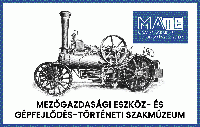SUMMARY
|
Formation and development of tillage tools and machines |
The most important tool of tillage is the from the ancient times. As Károly Koós wrote: „from the drawen forky wooden cudgel to wooden plough with steel parts through bronze fittings one led the bridge on wich the mankind went from wildness to civilisation.”
The ancient from of plough might be found out in more places independently each other. The plough and tillage went through a long development to gain their current forms. This chapter summarizes the way lasting thousands of years emphasizing the points and types which took the development a step forward. The author guides the reader on the route of development from the very beginning (B.C.) helped by the remaining memories connecting the plough (pictographs, pictures engraved in stone, characters), works of art (share, coulter, plough drawing chain) or by whole ploughs (Walle, Dabergotz ones and so on).
In the development of plough and tillage there are followed mainly those concerning Carpathian Basin. The ploughs of other lands of the world are only touched by the study there and such an extent where and how it is necessary to lead the development history line. The development history charts contain interesting complications which demonstrate as follows:
- medieval ploughs illustration history,
- development history of 1st-18th century ploughs,
- 19th-20th century animalüdrawn ploughs.
In the 19th century in Hungary the tillage was done with custom inherited from the ancestors. The wooden plough, wooden harrow, billetuwood and broom harrow were the most important „machine” tools. István Széchenyi’s reforms, the formation of Hungarian National Society of Economy were necessary to start a slow development. It was only the middle of the 19th century when the fabrication of some that time modern carter half-steel ploughs started. Efforts to develop tools used in agriculture were grouped invariably aorund the plough. The first plough competition and agricultural exhibition was organized in 1841 at Pest. In 1856 the director of Magyaróvár Institute of Economy brought a permanent exhibition into being in Moson. It showed ploughing, grubbing, amassing, hilling ploughs and harrows.
To the 1870’s years the tillage and its tools played the main rule henceforward in the Carpathian Basin agricultural production modernization. In 1871 there was 579 thousand wooden ploughs out of 1.1 million ones. It was only in the 20th century to when the wooden ploughs were replaced by the half-iron ones and those made of iron, steel.
The shaping of the plough body finished to the end of 19th century as the plogh tipe increase in number accelerated in the beginning of the 20th century. So the period between the two war was the golden age of animal drawn ploughs. The slow then accelrating rate of advance, the backwardness of tillage, and its recovery are underlined by a social and economic background.
The change in drawing power (from animal force to drawing by power machine) effects of course tremendeously on
the evolution and formation of plough and the other cultivation tools. The first trials to replace animal drawing followed the dicovery of steam energy and engine usage quite later (steam engine of James Watt). It was 1858 when a piece of news arrived from England about steam engine ploughing. There was a large number of trial, experiment until the tilting plough got shape in the beginning of 1850’s. In 1856 the winch vehicle one-machine steam plough system followed then by the twomachine one. In the Carpathian Basin the one engine ploughing was used first in 1861 and the two steam engine one in 1870.
It was the first decades of 20th century when the selfpropelled motorized ploughs presented themselves. In these the plough boides, the internal combustion engine were carried by a frame structure.
The study touch upon the special ploughing machine, which have not spreaded widely, but they were of great importance in their age (steam digging plogh, Mechwart’s shovel plough, electric, suction gas, naphta-motor cable ploughing appliances, Mechwart – Bánki’s petroleum plough, Kőszegi’s disintegrator).
The evolution history of plough and tillage are closed by the tractor drawn ploughs.
As the chapter covers the tillage so it gives a picture about their tools, machines advance history, too (harrow, roll, disc, cultivator).
2011 © Minden jog fenntartva!
info@gepmuzeum.szie.hu



